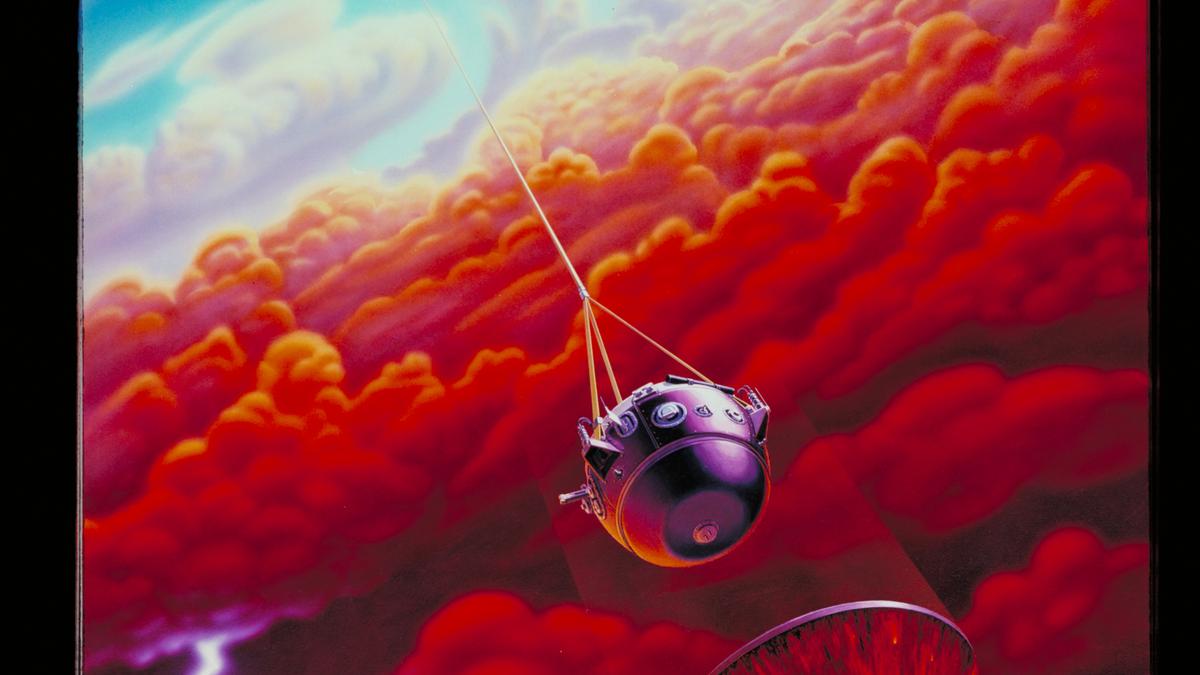Getting there
The Galileo Jupiter atmospheric probe was part of NASA’s Galileo mission – among the agency’s most ambitious deep space missions up until then. Before the probe could become Earth’s first ever emissary to penetrate the atmosphere of any of the outer gas giant planets, there was the task of getting the Galileo spacecraft in the vicinity of the Jovian system.
Following the successful flyby of Pioneer 10 and 11, and Voyager 1 and 2, in the 1970s, it became clear that a long-term mission to Jupiter was possible. It was nearly another decade before the Galileo mission became a reality, and it was launched on October 18, 1989.
A Venus flyby in 1990 followed by two Earth flybys in 1990 and 1992 were used as three slingshots, enabling Galileo to gain momentum on its journey to Jupiter. This flight path was dubbed by mission planners as VEEGA, which stands for Venus-Earth-Earth Gravity Assist.
In 1991, Galileo encountered the asteroid Gaspra, becoming the first spacecraft to flyby an asteroid. In 1993, it discovered the first moon around an asteroid as it spotted Dactyl orbiting Ida. It provided the only direct observations of a comet crashing with a planet in 1994 as it observed fragments of comet Shoemaker-Levy 9 crash into Jupiter. The following year, the mission reached a stage where the orbiter and probe could part ways.
Parting of ways
The Galileo mission carried a 337 kg probe that was based on the design of the large probe of the Pioneer Venus multi-probe and was tasked with returning data when it entered the atmosphere of Jupiter using a parachute. On July 13, 1995, when the main Galileo spacecraft was still around 80 million km from Jupiter, the atmospheric entry probe was released. Nearly five months later, on December 7, the probe hit the Jovian atmosphere.
For the next 58 minutes, the probe returned invaluable data as it plunged into the cauldron that was the Jupiter’s atmosphere. During the first two minutes of what was the most difficult atmospheric entry ever attempted, the probe endured maximum deceleration of 228 Gs (228 times the acceleration of gravity at Earth’s surface) and the temperatures soared up to 16,000 degrees Celsius – over twice as hot as the temperatures on the sun’s surface! Enormous pressure (22.7 atmospheres) meant that the probe’s transmitter failed 61.4 minutes after entry into the atmosphere when the probe was around 180 km below its entry ceiling.
It might have lasted for less than an hour, but whatever data was captured by the probe was first transmitted to the main spacecraft, which entered into orbit around Jupiter the same day the probe hit the atmosphere. The main spacecraft then transmitted this data back to Earth.
Based on the data that was returned, there was indication of an intense radiation belt about 50,000 km above Jupiter’s clouds. In addition to winds as high as 640 metres per second, there was also indications of a few organic compounds. As against expectations in the upper atmosphere of Jupiter, the probe’s data revealed less lightning and water vapour, and half the amount of helium.
What about the main mission?
Having entered into orbit around Jupiter, the primary mission got under way. While the primary mission was scheduled until December 1997, it received three extensions, lasting eventually until 2003. In those eight years, Galileo returned unprecedented amount of data about Jupiter and its system.
Beneath the icy, cracked, frozen surface of the moon Europa, Galileo found evidence for the possible existence of a salty ocean. The volcanic processes in the moon Io were observed and the spacecraft was able to show that some of these volcanoes were actually hotter than those on Earth. Additionally, the spacecraft was able to detect the first magnetic field around a satellite, in the case of Ganymede.
In order to protect one of its own discoveries – the possible existence of an ocean beneath the surface of Europa – it was decided that Galileo would be deliberately destroyed. The fact that Galileo had not been sterilised meant that it could contaminate surfaces that it impacted. Hence, Galileo forcibly plunged into Japan’s crushing atmosphere on September 21, 2003, bringing to an end a mission that changed the way we look at our solar system.
Labelled line drawing of Galileo spacecraft’s atmospheric probe identifies the deceleration module aft cover, descent module, and deceleration module aeroshell configurations and dimensions prior to and during entry into Jupiter’s atmosphere.
| Photo Credit:
NASA
Numbers from the descent of Galileo’s probe
When the probe slammed into the atmosphere of Jupiter, it was moving at the speed of 170,590 km per hour (more than 138 times the speed of sound). While such supersonic speeds of travel aren’t yet possible in our daily travel, it would be fast enough to jet from Chennai to Delhi in less than 40 seconds!
Deceleration from that speed to Mach 1, which is the speed of sound, took just a few minutes.
As the probe slowed from 170,590 km per hour to 160 km per hour, it experienced a force more than 200 times the Earth’s gravity at maximum deceleration.
Published – July 13, 2025 12:00 am IST
